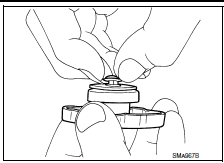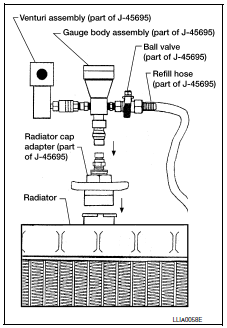Nissan Maxima Service and Repair Manual: Periodic maintenance
ENGINE COOLANT
System Inspection
WARNING: Do not remove the radiator cap when the engine is hot. Serious burns could occur from high pressure coolant escaping from the radiator. Wrap a thick cloth around the radiator cap. Slowly turn it a quarter turn to allow built-up pressure to escape. Carefully remove the radiator cap by turning it all the way.
CHECKING COOLING SYSTEM HOSES
Check hoses for the following:
- Improper attachment
- Leaks
- Cracks
- Damage
- Loose connections
- Chafing
- Deterioration
CHECKING RESERVOIR TANK LEVEL
- Check if the reservoir tank coolant level is within MIN to MAX range when the engine is cool.
- Adjust coolant level if it is too much or too little.
CHECKING COOLING SYSTEM FOR LEAKS

To check for leaks, apply pressure to the cooling system using suitable tool and Tool

Tool number : EG17650301 (J-33984-A)
Leakage test pressure : Refer to CO-27, "Radiator".
WARNING: Do not remove the radiator cap when the engine is hot. Serious burns could occur from high pressure coolant escaping from the radiator.
CAUTION: Higher pressure than specified may cause radiator damage.
CHECKING RADIATOR CAP
- Inspect the radiator cap.
- Replace the radiator cap if the metal plunger cannot be seen around the edge of the black rubber gasket.
- Replace the radiator cap if deposits of waxy residue or other foreign material are on the black rubber gasket or the metal retainer.
NOTE: Thoroughly wipe out the radiator filler neck to remove any waxy residue or foreign material
- Pull the negative-pressure valve to open it and check that it closes completely when released

Standard stroke: 0.7 mm - 1.7 mm (0.03 - 0.07 in)
- Check that there is no dirt or damage on the valve seat of the radiator cap negative-pressure valve.
- Check that there are no abnormalities in the opening and closing conditions of the negative-pressure valve.
- Check radiator cap relief pressure using suitable tool and Tool.

Tool number : EG17650301 (J-33984-A)
Standard : Refer to CO-27, "Radiator".
- When connecting the radiator cap to the tester, apply water or coolant to the radiator cap seal surface.
- Replace the radiator cap if there is an abnormality in the negative- pressure valve, or if the open-valve pressure is outside of the standard values.
CHECKING RADIATOR
Check radiator for mud or clogging. If necessary, clean radiator as follows.
CAUTION:
- Be careful not to bend or damage the radiator fins.
- When radiator is cleaned on-vehicle, remove surrounding parts
in order to access the radiator core.
Tape the harness and electrical connectors to prevent water from entering.
- Spray water to the back side of the radiator core using a side to side motion from the top down.
- Stop spraying when debris no longer flows from radiator core.
- Blow air into the back side of radiator core using a side to side motion from the top down.
- Use compressed air lower than 490 kPa (5 kg/cm2, 71 psi) and keep distance more than 30 cm (11.8 in).
- Continue to blow air until no water sprays out.
- Check for coolant leaks. Repair as necessary.
Changing Engine Coolant
WARNING: Do not remove the radiator cap when the engine is hot. Serious burns could occur from high pressure coolant escaping from the radiator. Wrap a thick cloth around the radiator cap. Slowly turn it a quarter turn to allow built-up pressure to escape. Carefully remove the radiator cap by turning it all the way.
DRAINING ENGINE COOLANT
- Remove the engine under cover. Refer to EM-23, "Removal and Installation".
- Open radiator drain plug at the bottom of radiator and remove the
radiator cap. This is the only step
required for a partial cooling system drain.
CAUTION: Do not allow the coolant to contact drive belt. - If removing the heater core, remove the upper heater hose from the engine coolant outlet and apply moderate air pressure of 103.46 kPa (1.055 kg-cm2, 15 psi) maximum for 30 seconds into the hose to blow out excess coolant from the core.
- For a complete cooling system drain, remove the reservoir tank and
drain the coolant, and then clean the
reservoir tank before installation.
CAUTION: Do not allow the coolant to contact drive belt. - When performing a complete cooling system drain remove the cylinder block front drain plug and the cylinder block RH drain plug.
- Check the drained coolant for contaminants such as rust, corrosion or discoloration.
- If contaminated, flush the engine cooling system.
REFILLING ENGINE COOLANT
1. Install the radiator drain plug. If the cooling system was drained completely, install the reservoir tank and the cylinder block drain plugs.
- The radiator must be completely empty of coolant and water.
- Apply sealant to the threads of the cylinder block drain plugs. Use Genuine High Performance Thread Sealant or equivalent.
Radiator drain plug : Refer to CO-14, "Exploded View".
Cylinder block front drain plug : 9.8 N*m (1.0 kg-m, 87 in-lb)
Cylinder block RH drain plug : 19.6 N*m (2.0 kg-m, 14 ft-lb)
- If disconnected, reattach the upper radiator hose at the engine side.
- Set the vehicle heater controls to the full HOT and heater ON position. Turn the vehicle ignition ON with the engine OFF as necessary to activate the heater mode.
- Install the Tool by installing the radiator cap adapter onto the radiator neck opening. Then attach the gauge body assembly with the refill tube and the venturi assembly to the radiator cap adapter.

Tool number : KV991J0070 (J-45695)
- Insert the refill hose into the coolant mixture container that is placed at floor level. Make sure the ball valve is in the closed position.
- Use recommended coolant or equivalent.
CAUTION: Do not use any cooling system additives such as radiator sealer. Additives may clog the cooling system and cause damage to the engine, transmission and/or cooling system.
Engine coolant capacity (with reservoir tank) : Refer to MA-15, "FOR USA AND CANADA : Fluids and Lubricants" (United States and Canada) or MA-16, "FOR MEXICO : Fluids and Lubricants" (Mexico).
- Install an air hose to the venturi assembly, the air pressure must be within specification.
Compressed air supply pressure : 549 - 824 kPa (5.6 - 8.4 kg/cm2, 80 - 119 psi)
CAUTION: The compressed air supply must be equipped with an air dryer.
- The vacuum gauge will begin to rise and there will be an audible hissing noise. During this process open the ball valve on the refill hose slightly. Coolant will be visible rising in the refill hose. Once the refill hose is full of coolant, close the ball valve. This will purge any air trapped in the refill hose.
- Continue to draw the vacuum until the gauge reaches 28 inches of vacuum. The gauge may not reach 28 inches in high altitude locations; use the vacuum specifications based on the altitude above sea level.

Altitude above sea level Vacuum gauge reading
0 - 100 m (328 ft) : 28 inches of vacuum
300 m (984 ft) : 27 inches of vacuum
500 m (1,641 ft) : 26 inches of vacuum
1,000 m (3,281 ft) : 24 - 25 inches of vacuum
- When the vacuum gauge has reached the specified amount, disconnect the air hose and wait 20 seconds to see if the system loses any vacuum. If the vacuum level drops, perform any necessary repairs to the system and repeat steps 6 - 8 to bring the vacuum to the specified amount. Recheck for any leaks.
- Place the coolant container (with the refill hose inserted) at the
same level as the top of the radiator. Then
open the ball valve on the refill hose so the coolant will be drawn up to
fill the cooling system. The cooling
system is full when the vacuum gauge reads zero.
CAUTION: Do not allow the coolant container to get too low when filling, to avoid air from being drawn into the cooling system.
- Remove the Tool from the radiator neck opening.
- Fill the cooling system reservoir tank to the specified level and install the radiator cap. Run the engine to warm up the cooling system and top up the system as necessary.
- Install the engine under cover. Refer to EXT-15, "Exploded View".
FLUSHING COOLING SYSTEM
- Fill the radiator from the filler neck above the radiator upper hose and reservoir tank with clean water and reinstall radiator cap.
- Run the engine and warm it up to normal operating temperature.
- Rev the engine two or three times under no-load.
- Stop the engine and wait until it cools down.
- Drain the water from the system. Refer to CO-11, "Changing Engine Coolant".
- Repeat steps 1 through 5 until clear water begins to drain from the radiator.
 Cooling system
Cooling system
Cooling Circuit
Cylinder block (RH)
Oil cooler
Cylinder head (RH)
Water pump
Radiator
Water inlet
Thermostat
Cylinder head (LH)
Cylinder block (LH)
To heater
T ...
Other materials:
Operating tips
When the engine coolant temperature and
outside air temperature are low, the air flow
from the foot outlets may not operate for a
maximum of 150 seconds. However, this is
not a malfunction. After the coolant temperature
warms up, air flow from the foot outlets
will operate normally.
...
Both side headlamps do not switch to high beam
Description
The headlamps (both sides) do not switch to high beam when the lighting
switch is in the HI or PASS setting.
Diagnosis Procedure
1.COMBINATION SWITCH (LIGHTING AND TURN SIGNAL SWITCH) INSPECTION
Check the combination switch (lighting and turn signal switch).
2.CHECK HEADLAMP (HI) ...
NISSAN Intelligent Key battery discharge
If the battery of the NISSAN Intelligent Key is
discharged, or environmental conditions interfere
with the Intelligent Key operation, start the engine
according to the following procedure:
1. Place the shift lever in the P (Park) position.
2. Firmly apply the foot brake.
3. Touch the i ...
Nissan Maxima Owners Manual
- Illustrated table of contents
- Safety-Seats, seat belts and supplemental restraint system
- Instruments and controls
- Pre-driving checks and adjustments
- Monitor, climate, audio, phone and voice recognition systems
- Starting and driving
- In case of emergency
- Appearance and care
- Do-it-yourself
- Maintenance and schedules
- Technical and consumer information
Nissan Maxima Service and Repair Manual
0.0072

